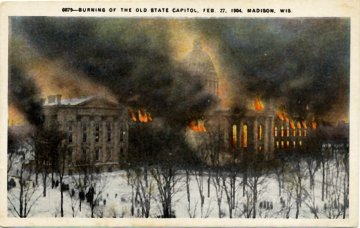
WLA’s Centennial Celebration


Wisconsin Library Heritage Center
The Wisconsin Library Heritage Center is a program of the Wisconsin Library Association Foundation promoting understanding and appreciation of the history of libraries and librarianship in Wisconsin.

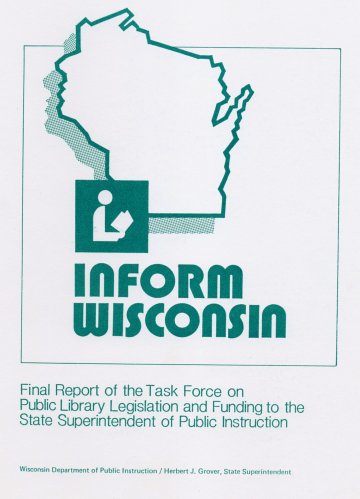



 When World War I broke out in Europe in 1914 the United States was officially neutral. However, it proved impossible for the United States to maintain its neutrality and on April 6, 1917, President Woodrow Wilson signed a declaration of war against Germany. The American Library Association saw an opportunity to provide library service to the men in the armed forces, and in June of 1917 it established a War Service Committee. During and after WWI the ALA Library War Service provided millions of books and magazines to soldiers, sailors, marines, and merchant mariners in the U.S. and in Europe. Wisconsin libraries actively cooperated with the American Library Association in its efforts to provide books for soldiers and sailors during World War I. This included participation in nationwide fundraising efforts. Matthew S. Dudgeon, Secretary of the Wisconsin Free Library Commission, took a leave of absence to serve in the Library War Service. He was in charge of all camp libraries in the U. S., and later served in France. A Wisconsin Library War Council was established to help raise funds “To Buy Good Books for the Soldiers” (see receipt above). The Wisconsin Library Heritage Center sponsors library history related exhibits in libraries. One of those exhibits was about the role libraries played in World War I.
When World War I broke out in Europe in 1914 the United States was officially neutral. However, it proved impossible for the United States to maintain its neutrality and on April 6, 1917, President Woodrow Wilson signed a declaration of war against Germany. The American Library Association saw an opportunity to provide library service to the men in the armed forces, and in June of 1917 it established a War Service Committee. During and after WWI the ALA Library War Service provided millions of books and magazines to soldiers, sailors, marines, and merchant mariners in the U.S. and in Europe. Wisconsin libraries actively cooperated with the American Library Association in its efforts to provide books for soldiers and sailors during World War I. This included participation in nationwide fundraising efforts. Matthew S. Dudgeon, Secretary of the Wisconsin Free Library Commission, took a leave of absence to serve in the Library War Service. He was in charge of all camp libraries in the U. S., and later served in France. A Wisconsin Library War Council was established to help raise funds “To Buy Good Books for the Soldiers” (see receipt above). The Wisconsin Library Heritage Center sponsors library history related exhibits in libraries. One of those exhibits was about the role libraries played in World War I.
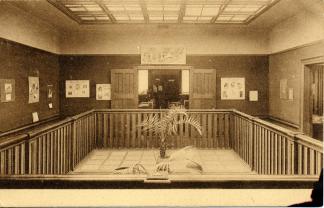
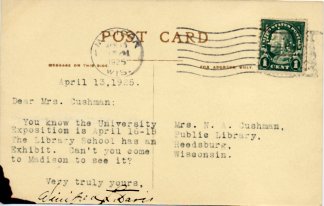

 Under the leadership of Melvil Dewey, the State of New York initiated a state funded traveling library system in 1892. Traveling libraries were small rotating collections that provided a method for extending library service to rural areas. These small libraries usually from 30 to a hundred books were located in a post office or store with a volunteer acting as the caretaker of the collection. In New York the collections stayed in one location for six months before they were rotated. Michigan initiated a similar system in 1895 and Iowa in 1896.
Under the leadership of Melvil Dewey, the State of New York initiated a state funded traveling library system in 1892. Traveling libraries were small rotating collections that provided a method for extending library service to rural areas. These small libraries usually from 30 to a hundred books were located in a post office or store with a volunteer acting as the caretaker of the collection. In New York the collections stayed in one location for six months before they were rotated. Michigan initiated a similar system in 1895 and Iowa in 1896.
Traveling libraries began in Wisconsin in 1896, when Senator James Huff Stout of Menomonie, Wisconsin privately funded a system of these libraries for Dunn County. He provided 500 books divided into collections of 30 volumes each. He was assisted in the selection of titles to be included by the Wisconsin Free Library Commission which began in 1895. Senator Stout along with Lutie Stearns and Frank Hutchins had been instrumental in starting the Commission. More about Wisconsin’s traveling libraries can be found HERE. The image below shows a Stout Traveling Library bookcase at the Dunn County Historical Society.
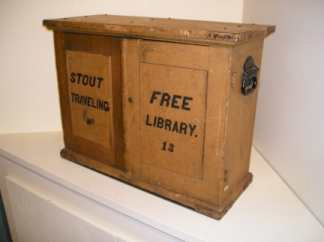


 On January 31, 2006 the Wisconsin Library Association Foundation (WLAF) launched the Campaign for Wisconsin Libraries in the State Capitol to promote a better understanding of how libraries contribute to the state’s economic growth, education and lifelong learning, and the quality of life in Wisconsin. With the theme “Support Wisconsin Libraries: Keep Us All in a Better State” the aggressive public relations and fund raising campaign included a variety of promotional materials, radio spot announcements, and a website WisconsinLibraries.org. The Campaign included an ambitious goal of raising $100,000 a year to promote libraries of all types. The photo above is a group shot of attendees at the 2007 WLA conference in Green Bay wearing a tee shirt promoting the campaign. It was taken by Steven Platetter. Promotional materials included posters, bookmarks, and buttons with a variety of catchy slogans including “If knowledge is power, libraries are power plants.” The Campaign for Wisconsin Libraries has gradually faded from its original enthusiasm and is no longer active.
On January 31, 2006 the Wisconsin Library Association Foundation (WLAF) launched the Campaign for Wisconsin Libraries in the State Capitol to promote a better understanding of how libraries contribute to the state’s economic growth, education and lifelong learning, and the quality of life in Wisconsin. With the theme “Support Wisconsin Libraries: Keep Us All in a Better State” the aggressive public relations and fund raising campaign included a variety of promotional materials, radio spot announcements, and a website WisconsinLibraries.org. The Campaign included an ambitious goal of raising $100,000 a year to promote libraries of all types. The photo above is a group shot of attendees at the 2007 WLA conference in Green Bay wearing a tee shirt promoting the campaign. It was taken by Steven Platetter. Promotional materials included posters, bookmarks, and buttons with a variety of catchy slogans including “If knowledge is power, libraries are power plants.” The Campaign for Wisconsin Libraries has gradually faded from its original enthusiasm and is no longer active.